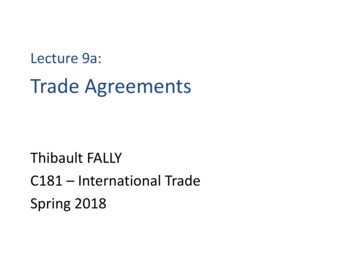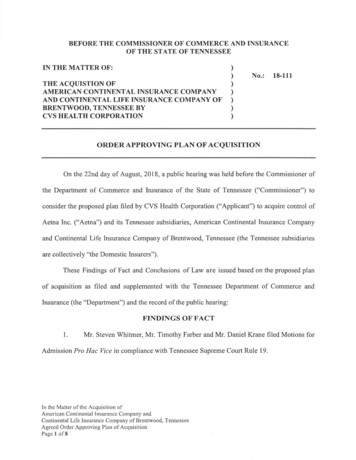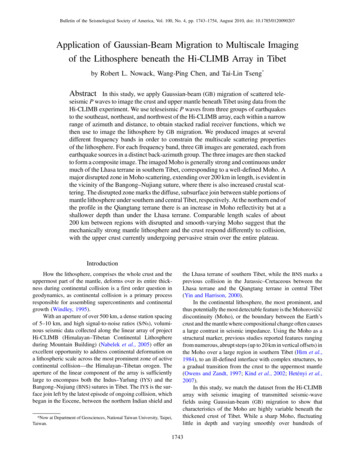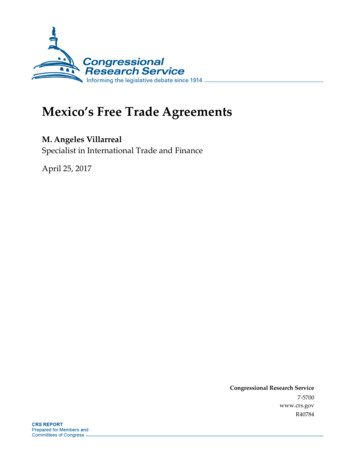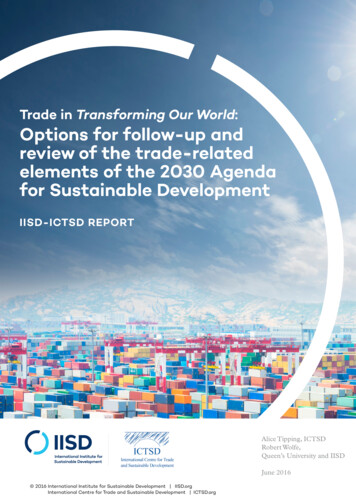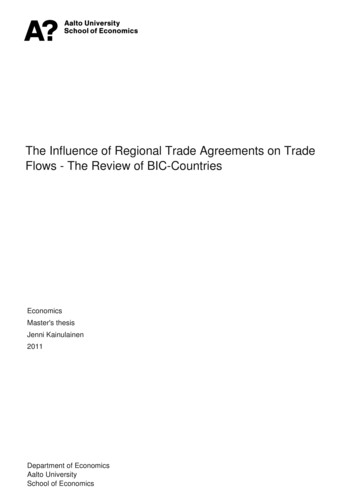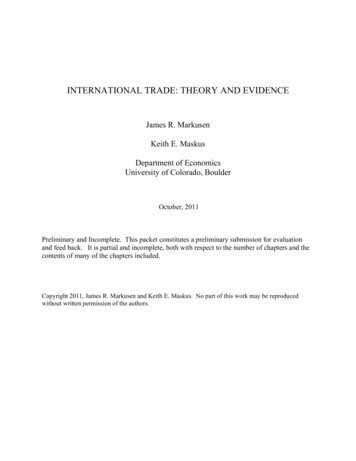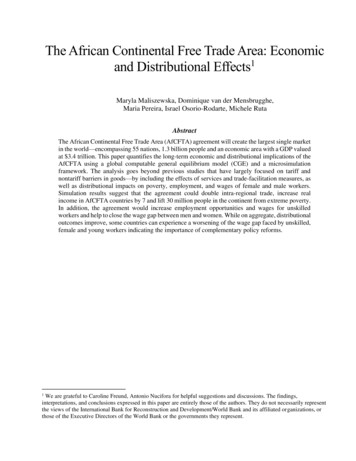
Transcription
The African Continental Free Trade Area: Economicand Distributional Effects1Maryla Maliszewska, Dominique van der Mensbrugghe,Maria Pereira, Israel Osorio-Rodarte, Michele RutaAbstractThe African Continental Free Trade Area (AfCFTA) agreement will create the largest single marketin the world—encompassing 55 nations, 1.3 billion people and an economic area with a GDP valuedat 3.4 trillion. This paper quantifies the long-term economic and distributional implications of theAfCFTA using a global computable general equilibrium model (CGE) and a microsimulationframework. The analysis goes beyond previous studies that have largely focused on tariff andnontariff barriers in goods—by including the effects of services and trade-facilitation measures, aswell as distributional impacts on poverty, employment, and wages of female and male workers.Simulation results suggest that the agreement could double intra-regional trade, increase realincome in AfCFTA countries by 7 and lift 30 million people in the continent from extreme poverty.In addition, the agreement would increase employment opportunities and wages for unskilledworkers and help to close the wage gap between men and women. While on aggregate, distributionaloutcomes improve, some countries can experience a worsening of the wage gap faced by unskilled,female and young workers indicating the importance of complementary policy reforms.1We are grateful to Caroline Freund, Antonio Nucifora for helpful suggestions and discussions. The findings,interpretations, and conclusions expressed in this paper are entirely those of the authors. They do not necessarily representthe views of the International Bank for Reconstruction and Development/World Bank and its affiliated organizations, orthose of the Executive Directors of the World Bank or the governments they represent.
1. INTRODUCTIONOn March 21, 2018, at the 10th Extraordinary Summit of the African Union, almost all countries on theAfrican continent signed the African Continental Free Trade Area Agreement (AfCFTA) creating thelargest free trade area in the world—connecting 55 countries and 1.3 billion people. The combined GDPof AfCFTA economies is valued at 3.4 trillion. The agreement officially entered into forceon May 30, 2019 after ratification of the agreement by 22 countries (see Figure 1 below). AfCFTA aims ataddressing the long-standing economic fragmentation of Africa. Existing trade barriers remain high across thecontinent. While statutory tariffs have been reducedFigure 1: AfCFTA member countries, by status of ratificationbelow 5 percent for roughly half of the countries,they remain high for sensitive sectors. There aremany other barriers that are restricting continentaleconomic integration—non- tariff barriers inservices and other sectors, weak and fragmentedrules to promote investment and competition,inadequate institutions such as customsmanagement to facilitate trade.African countries account for less than 3 percentof world trade and GDP, but 16.7 percent ofpopulation (Figure 2). Poverty reduction remains acritical priority. The signatory countries trade littlewith each other—less than 8 percent of theirexports are directed to other prospective member Source: Authors’ estimates.countries. This share is low even compared to intra- Note: As of October 29, 2019. The map was constructed withregional trade in Africa, which is around 11 available layers in Tableau version 10.5. As a result, the map abovepercent, suggesting that there are important does not represent the official position of the World Bank or itsconstraints to the growth of regional trade. The Board of Directors. This visualization was generated exclusively fordrafting this report.poverty headcount ratios are high in AfCFTAcountries, averaging 32.2 percent, ranging from Madagascar with 77.8 percent of the population living below thepoverty line ( 1.90 a day) to Algeria and Mauritius, with 0.5 percent.2This study assesses the potential economic implications of AfCFTA, quantifying the impacts using acomputable general equilibrium model (CGE) calibrated to the most recent database produced by theGlobal Trade Analysis Project (GTAP). The GTAP database is supplemented by additional data that quantifiessome of the other aforementioned barriers to trade, that, if part of the integration package, could support theelimination of tariffs in boosting trade integration and accelerating growth. To date, macroeconomic studies onthe economic implications of Africa’s regional integration have mainly focused on tariff and non-tariff barriers(NTBs) in goods. Our study extends the analysis to cover NTBs in services and other sectors and trade facilitationmeasures. Most importantly, we extend the analysis to investigate the implications of AfCFTA for poverty,income distribution, impacts on unskilled workers, youth, and women.We designed the forward-looking scenarios by employing the global dynamic CGE model and the globalmicrosimulation framework Global Income Distribution Dynamics (GIDD). This approach allows for theanalysis of global development and structural transformation, incorporating the complex interactions ofproductivity differences at the country, sector, or factor level; shifts in demand as income rises; demographicand skill dynamics in factor markets; and changes in comparative advantage and trade flows from globalizationor trade liberalization. The analysis on distributional outcomes of AfCFTA required i) building a new dataseton employment and wages of female and male workers at the industry level across AfCFTA members; ii)building a gender sensitive CGE model; and iii) updating several household surveys to be used in themicrosimulations (see Annex G: Data preparation on disaggregated labor volumes and wages).2These statistics do not cover informal or small-scale cross border trade flows, which have been estimated to provide income to 43% ofAfrican population (Afrika; and Ajumbo 2012), support poverty reduction and improve food security.
While there are several sub-regionalintegration agreements in Africa that aim in Figure 2: Trade, GDP and Population in the African Continentpart at achieving the same set of goals, the as a share of global total (percent)impact of AfCFTA is likely to stem from twomain features. First, in the policy areas that arealready covered by sub- regional agreements,AfCFTA will provide a non-discriminatoryreduction in tariffs and a common regulatoryframework, thereby reducing fragmentation of thecontinental market. Second, sub-regionalagreements in Africa tend to be relatively shallowcovering few of the non-tariff measures that affecttrade integration. AfCFTA could make substantialprogress in ensuring NTBs are more conducive tocontinental trade integration. Specifically, in orderto assess the implications of AfCFTA, the analysis Source: World Development Indicatorsdevelops a set of policy scenarios to cover: i) tariffchanges differentiating between the timeframe of tariff liberalization of least developed countries (LDCs) andnon-LDCs; ii) reduction of NTBs in goods and services; iii) improvements in trade facilitation.The study presents background information on the content of AfCFTA and the data used for the quantificationexercise. It then presents the key findings of the macroeconomic simulations and the analysis of the distributionalimpacts of the agreement.2. THE CONTENT OF AFCFTA AND AFRICAN-SUB REGIONAL TRADE AGREEMENTSAt its launch, the Framework Agreement establishing the African Continental Free Trade Area (AfCFTA)was signed by 44 countries at a Summit of the African Union (AU) held in Kigali, Rwanda, on March21st, 2018. AfCFTA was proposed in 20123 and hopes were that an agreement would be reached in 2017.The first phase comprised negotiation of three Protocols for: (i) Trade in Goods;4 (ii) Trade in Services;5 and (iii)Rules and Procedures for Settlement of Disputes.The Agreement requires members to progressively remove tariffs on at least 97 percent of tarifflines that account for 90 percent of intra-African imports.6 Average tariffs are 6.1 percent, but with a highvariation across countries and sectors. Intra- African trade is highly concentrated, with 1 percent of tariff linesaccounting for 74 percent of imports in the average African country. Thus, some of the most onerous andprotectionist tariffs may be maintained even if countries liberalize most tariff lines.Trade in select sensitive sectorsis expected to be liberalized over a longer period, and other goods are likely to remain excluded from liberalization.73African Union Assembly Decision Assembly/AU/Dec. 394(XVIII) as part of the Action Plan on Boosting Intra- Africa Trade in Africa(BIAT).4The overarching aims of the agreement with respect to goods are: i) Progressive elimination of tariffs; ii) Progressive elimination ofnon-tariff barriers; iii) Enhancing the efficiency of customs, trade facilitation, and transit; iv) Cooperation on Technical Barriers to Trade(TBT) and Sanitary and Phytosanitary (SPS) measures; v) Development and promotion of regional and continental value chains; vi)Socio-economic development, diversification and industrialization across Africa5The overarching aims of the agreement with respect to services are: i) Enhance competitiveness of services; ii) Promote sustainabledevelopment; iii) Foster investment; iv) Accelerate efforts on industrial development to promote the development of regional value chains;v) Progressively liberalize trade in services6A special dispensation for 7 LDCs has also been tabled,providing for a reduced level of ambition on tariff liberalization. Djibouti, Ethiopia,Madagascar, Malawi, Sudan, Zambia, and Zimbabwe will be expected to meet a reduced level of ambition of 85 percent of tariffs at entryinto force of AfCFTA, with a 15-year period to reach 90 percent.7AfCFTA could use the lessons from the most recent World Bank’s analysis of trade policy and barriers in CEMAC. World Bank(2018) finds that trade within CEMAC remains limited despite a significant regional integration effort.
The AfCFTA annex on rules of origin is yet to be finalized. Rules of origin describe the transformation aproduct must undergo in the region, such as the share of value added, to enjoy preferential market access. They areused to prevent goods from non-member countries entering through a low-tariff country and being transshippedduty free to another member country. Rules of origin that are too restrictive can negate the preferential marketaccess intended by the free trade agreement and prevent global supply chains from functioning. South Africa andNigeria expressed concerns that too lenient or mismanaged rules of origin will provoke a flood of extra-regionalproducts coming in with low levels of value addition.Services negotiations began in June 2018, and countries have identified five priority sectors, namelyfinancial services, transport, telecom/IT, professional services, and tourism. The benefits of servicesliberalization extend far beyond the service sectors themselves; they affect all other economic activities that useservices as inputs. A second phase of negotiations will focus on investment, competition, and intellectual propertyrights, with a potential of deepening AfCFTA. Research finds that deep trade agreements boost trade, foreigninvestment, and participation into global value chains (Mattoo, Mulabdic, and Ruta 2017; Mulabdic, Osnago, andRuta 2017; Laget et al. 2018). Yet, these areas also involve complex negotiations.An important question is how AfCFTA will complement existing African sub- regional preferential tradeagreements (PTAs). This study provides an analysis of the content of AfCFTA based on the legal text of the agreementand compares it with the policy areas covered in existing African PTAs.8 The analysis indicates that AfCFTA couldpromote regional economic integration in Africa in two ways. First, in the policy areas that are already covered by subregional PTAs, AfCFTA will offer a common regulatory framework, thereby reducing market fragmentation created bydifferent sets of rules. Second, African sub-regional trade agreements tend to be shallow. AfCFTA will be an opportunityto regulate policy areas important for economic integration that are often regulated in trade agreements but have so farnot been covered in most African PTAs.For this study, we focus on the following African sub-regional PTAs, which are in force and have beennotified to the World Trade Organization (WTO) as of September 2019: The Common Market for East andSouth Africa (COMESA); the East African Community (EAC); the Economic Community of West African States(ECOWAS); the South African Development Community (SADC); the South African Customs Union (SACU);West African Economic and Monetary Union (WAEMU); and the Economic and Monetary Community ofCentral Africa (CEMAC).9 The detailed references to the legal text of the agreements are in Annex A: Deepcommitments in African RECs – legal texts.Understanding the detailed content of trade agreements beyond tariffs is essential to appreciate theirpotential effects. Modern-day PTAs are not just more common instruments of trade policy liberalization,countries participating in PTAs have deepened and expanded their scope.10 The average PTA in the 1950s coveredeight policy areas. In recent years the number went up to 17. “Deep” trade agreements matter for economicdevelopment. The rules embedded in these agreements contribute to determine how economies function and,hence, grow. For example, trade and investment regimes determine the extent of economic integration,competition rules affect economic efficiency, intellectual property rights protections matter for innovation.8The analysis of the sub-regional PTAs draws on the World Bank database on the content of trade agreements (Hofmann, Osnago, andRuta 2017) which is based on the review of policy areas covered in the PTAs’ main legal instrument or founding treaty. The analysis ofAfCFTA is based on the text of the agreement signed in March 2018 establishing the continental free trade area.9Not included in this study are four Regional Economic Communities (RECs) that are recognized by AfCFTA Agreement but are not tradeagreements that have been notified to the WTO: The Arab Maghreb Union (UMA); the Community of Sahel-Saharan States (CEN-SAD);the Economic Community of Central African States (ECCAS); and the Intergovernmental Authority on Development (IGAD). SACU,WAEMU, and CEMAC are not acknowledged as RECs in AfCFTA Agreement (Art.1(t)) but fall within the ambit of Article 19(2) of AfCFTATreaty.10Preferential trade agreements have always been a feature of the world trading system, but their prominence has changed in recent years.The number of PTAs has increased from 50 in the early 1990s to roughly 300 in 2019. All WTO members are currently party of one,and often several, PTAs.
The inclusion of new policy areas in PTAs is not random. As shown in Mattoo, Mulabdic, and Ruta (2017),trade agreements covering few policy areas generally focus on traditional trade policy areas, such as tariffliberalization or customs. Agreements with broader coverage tend to include trade-related regulatory issues, suchas technical barriers to trade, or subsidies. Finally, agreements with large numbers of provisions often includepolicy areas that are not directly related to trade, such as labor, environment, and migration issues.11 In this analysisof the content of AfCFTA and the African sub-regional PTAs, we focus on the 20 policy areas most commonlyincluded in trade agreements in force and notified to the WTO.Table 1: Overview of policy areas covered in sub-regional African PTAs compared to AfCFTANote: Explanation: 1 policy area covered; 0 policy area not coveredTRIPS Trade-Related Aspects of Intellectual Property Rights; STE State Trading Enterprises;TBT Technical Barriers to Trade; GATS General Agreement on Trade in Services; SPS Sanitary andPhytosanitary Measures; IPR Intellectual Property Rights;TRIMS Trade-Related Investment MeasuresSource: Based on (Hofmann, Osnago, and Ruta 2017).There are two policy areas that have not (except for a few occasions) been covered in the Africansub-regional PTAs, but are included in AfCFTA. One is intellectual property rights, which is onlycovered in one sub-regional African PTA.12 Moreover, while none of the sub-regional African PTAs covers thearea of state-trading enterprises (STE). AfCFTA includes this policy area.11A study of EU and US trade agreements identifies a total of 52 potential policy areas covered in PTAs (Horn, Mavroidis, and Sapir2010).12EAC
Finally, while AfCFTA is deeper than any of the existing sub-regional PTAs, there are some policy areas that areincluded in individual sub-regional PTAs but not in AfCFTA. Examples of these areas are state aid (i.e. subsidies),13environmental laws,14 labor market regulations,15 and public procurement.16 The lack of inclusion of these policyareas in AfCFTA does not prevent countries to aim for common regulations at a later stage and does not affect thecommitments taken by countries in the context of the sub-regional PTAs.An important issue is how inconsistencies or conflict between different jurisdictions, sub-regional orregional will be addressed. As a general comment,Art.19 of AfCFTA Treaty refers to “conflict and inconsistencywith Regional Agreements”.Art.19(1) establishes that, unless otherwise provided, AfCFTA prevails in case ofinconsistencies. At the same time, Art.19(2) refers to the case of “higher levels of regional integration” than thoseestablished in AfCFTA, such as for example in “regional economic communities, regional trading arrangementsand custom unions”. In the latter situation, and as a general rule, States Parties maintain such higher levels amongthemselves. It remains to be seen how this will be implemented in practice.3. LITERATURE REVIEWOur results are broadly in line with the existing literature on the quantitative impacts of AfCFTA. Allstudies conducted so far have focused on the evaluation of implications of tariff and NTM reduction as well as tradefacilitation measures on African welfare.The studies are reviewed in Annex G.The Table 1 below summarizes the keyfindings of CGE and structural trade models in terms of economic growth and trade implications of AfCFTA. Despitethe fact that all previous CGE studies apply comparative static simulations and are based on older data sets (GTAPversion 9 or earlier) and often more aggressive trade liberalization scenarios (full tariff liberalization, full eliminationof NTBs), our results are broadly aligned. Consistently, the biggest gains are expected from the reduction of NTBsand trade facilitation with significant increases in intra-African trade between 50-132 percent and GDP gainsbetween 1-4 percent.13EAC, COMESA, SADC, CEMACEAC, COMESA, ECOWAS, CEMAC15EAC, COMESA16EAC14
Table 2: Summary of key findings from the literatureSource: Authors’ estimates
4. DATA AND METHODOLOGYDataThe core data is sourced from the GTAP database (Aguiar et al. 2019). It provides a snapshot of the globaleconomy in 2014—including domestic inter-industry flows and bilateral trade flows. The full database has 141regions, of which 121 are individual countries, and 65 sectors. For the purposes of this study, the 141 regions areaggregated into 37 regions including all 32 regions in Africa that are part of the database, of which 24 are individualcountries with the remaining countries aggregated into five regional components. The 65 sectors are aggregated into21. The GTAP data is based on official trade flows, but the magnitude of small-scale cross border trade is estimatedto be substantial in Africa (Box 1) leading to underestimation of the actual trade flows.The core data is supplemented with additional information. GTAP’s tariff rates are replaced with the mostrecent estimates, as measured by the World Bank. In addition, the study incorporates estimates of NTBs. The NTBsfor goods are sourced from World Bank’s World Integrated Trade Solution (WTIS) database and documented inKee et al. (2009). These are aggregated to the model’s regional and sector aggregation using trade weights. Estimatesfor the missing countries/regions are given by the simple average of the available estimates.The NTBs for servicesare sourced from Jafari and Tarr (2015).These are provided for 11 services that are mapped to an aggregation ofGTAP services.These three sources of data are incorporated into the 2014 reference year using a procedure that aimsto preserve as much as possible the original structure of the aggregated GTAP database.Global dynamic computable general equilibrium modelThe quantitative estimates of the impacts of AfCFTA rely on the Envisage computable general equilibriummodel. It is a recursive dynamic model, calibrated to the GTAP database and has been at the World Bank for a numberof studies17.The baseline, or reference simulation, runs from 2014 through 2035.The simulation is calibrated to the UNpopulation projection (2015 Revision), combined with a long-term socio-economic scenario developed by theIntegrated Assessment Modeling (IAM) community—the so-called socio-economic pathways (SSPs).There are fivesuch pathways describing different possible storylines of the evolution of global GDP. SSP2 was selected for this study,the so-called ‘Middle of the Road Scenario’.Distributional impacts of AfCFTAThe poverty and distributional impacts of AfCFTA depend on the changes in relative prices across andwithin countries. To capture the full—between and within country—distributional change, one needs a frameworkthat captures both effects at the macro level (country averages) and the evolution of factor markets at the micro level(dispersion). To account for both effects, this paper uses the GIDD microsimulation framework in combination withthe Envisage global CGE model.18 Both tools have been developed at the World Bank and are described in detail byBourguignon, Bussolo, and Pereira da Silva (2008); Bussolo, De Hoyos, and Medvedev (2010); and van derMensbrugghe (2013).The next sub-sections briefly describe the GIDD features.17In the context of Belt and Road Initiative (Maliszewska and van der Mensbrugge, 2019) or Comprehensive and Progressive TransPacific Partnership (Maliszewska, Olekseyuk and Osorio-Rodarte, 2018) and others.18The origin of dynamic microsimulation can be traced back to the 1950s seminal work of Orcutt (1957), whose contributions aimed atovercoming the limitations of models available at that time. Orcutt observed that those earlier models could be used to predict theaggregate impact but could not describe the distributional impact of policy reforms nor the effects on inequality of long-term trends, suchas demographic change. Data availability and modeling have significantly advanced since then, yet dynamic microsimulations remain themain tool to study distributional change and to provide the unique perspective of projecting samples of population forward in time.
Box 1: The Importance of Small-Scale Cross-Border19 Trade in Africa18While deeper regional integration is one of the key trade policy objectives for countries in Africa, a large part of intraAfrican trade currently goes unrecorded. This is because cross-border transactions often take place at a small scale andsuch consignments are not captured by standard statistical recording of trade through customs declarations. Because thenumber of small shipments can be very large, the total unrecorded volume and value of trade can be substantial.Hence, official trade statistics are incomplete and possibly misleading. Indeed, the poor quality of official tradestatistics is seen as one reason why recorded regional trade in Africa remains surprisingly low (Golub, 2015). As oneexample, the Petite-Barriere border crossing between Rwanda and the Democratic Republic of Congo (DRC) in Gomais one of the busiest borders in Africa with more than 40,000 small-scale traders crossing on a normal day.In turn, policymakers lack a holistic and complete understanding of the magnitude of, and impediments to, intra-regional trade that isrequired to design effective trade and investment policies.These unrecorded cross-border transactions are sometimes casually referred to as “informal trade” or “illegal trade”.However, while many small-scale traders may not be registered as formal business owners, this informal status does notimply that they are intentionally trying to circumvent existing laws,applicable taxes, or relevant procedures (Brenton andSoprano, 2018). Moreover, some individuals might conduct both formal and informal activities, they might pay one taxand not another, or complete one formality and not another (WCO, 2015). Previous research has shown that small-scaletraders and the producers and consumers they connect fall into the bottom third of the population by household income.Thus, small-scale cross-border trade (SSCBT), is directly relevant for poverty reduction (Brenton et al., 2013). In addition,SSCBT also makes a notable contribution to regional food security by linking markets across borders. A large proportionof small-scale operators at border crossings tend to be female. Women assume a variety of roles in small-scale trade asborder traders, transporters, processors, or vendors. In many cases, they face more severe impediments to trade than theirmale colleagues in the form of higher trade costs and more pervasive corruption, more limited access to price and marketinformation, and more frequent harassment and abuse (Brenton et al., 2013;Aboudou et al., 2017).A range of studies based on surveys at borders attest to the importance of small-sale trade across a range of countries inAfrica. For example, Bensassi et al., (2018) analyze data from interviews with 8,883 traders at border crossing points ofBenin with Togo and Nigeria. They find that unrecorded imports into Benin are as important as recorded imports, whilefor exports,the value of unrecorded transactions are more than five times higher than official exports reported in customsstatistics. In addition, the statistical offices of Uganda and Rwanda have been monitoring quantitative and qualitativeaspects of SSCBT since 2005 and 2010,respectively. These efforts provide for the most rigorous and reliable assessments ofthe importance of SSCBT.Uganda’s approach has been to send enumerators to targeted borders for two weeks per monthto capture SSCBT trade flows through observation and then to extrapolate the data for full-month coverage. Rwanda usesenumerators recruited in the border areas who work with electronic tablets and administer a survey throughout the year.In both countries, the observed SSCBT has been substantial. In 2017, almost 16 percent ( 550 million) of Uganda’s totalexports were due to small-scale trade but at the regional level almost 30 percent of Uganda’s exports to neighbors wereSSCBT.About 60 percent of Uganda’s exports to the DRC consists of SSCBT. Similarly, for Rwanda, around 11 percentof total exports is small-scale with this rising to 45 percent for exports to neighbors. More than half of Rwanda’s importsfrom Burundi and a quarter of imports from the DRC are due to small-scale trade.The magnitude and importance of small-scale trade in Africa suggest that policy reforms such as AfCFTA shouldaddress the extensive barriers to such trade. If this occurs the increase in regional trade will be substantially higher than ispredicted by using officially recorded trade dataEmployment volume and remunerations, gender and skillDetailed labor statistics by gender and skill are needed to assess the economic impact of AfCFTA beyondits macroeconomic aggregates, deepening the CGE model capacities to account for and draw conclusionsabout employment and its remunerations for specific segments of the population (e.g., women or the youth).Additional labor market information was incorporated for each country and activity in the GTAP version 10 database.The initial levels of employment as of 2014 with average remunerations (in US ) for four different types of workersthat were differentiated based on their gender (male and female) and educational attainment (skill and unskilled) (seeThis box is based on Walkenhorst, P (2019) ‘Data Collection on Small-Scale Cross-Border Trade:An Overview’, forthcoming policynote, World Bank.19
Table 3). These statistics were constructed using harmonized nationally-representative household surveys availablein the World Bank and the Luxembourg Income Study. Due to the natural inconsistency between macro- and microbased statistics, adjustments were performed so that total volumes and wages added up to national accounts. Thisprocedure is explained in detailed in Annex G. Figure 3 below summarizes, in a box and whisker plot, the initialdistribution of female employment by economic activity for AfCFTA countries. On the horizontal axis, a value infemale labor intensity greater than 1 indicates that an economic activity employs a greater proportion of womenthan the rest of the economy.20Across Africa, the economic activities that tend to employ more women are those inservices (recreational and other services, insurance, real estate, trade, and financial) and the textiles and wearingapparel sector. In contrast, women tend to be employed the least in construction, mining, and road and rail transportservices. While this is true in general, the box and whisker plot show also that there is significant variation of femalelabor intensity across the African continent.Figure 3: Female employment intensity in the disaggregated labor database for AfCFTA countriesSource: Authors’ estimatesNote: n.e.s. stands for not elsewhere specifiedThe second set of data that complement the CGE model relate to the expected formation of skillsin each country. Projections for the working age population by gender, 5-year age g
largest free trade area in the world . ranging from Madagascar with 77.8 percent of the population living below the poverty line ( 1.90 a day) to Algeria and Mauritius, with 0.5 percent.2 This study assesses the potential economic implications of AfCFTA, quantifying the impacts using a




